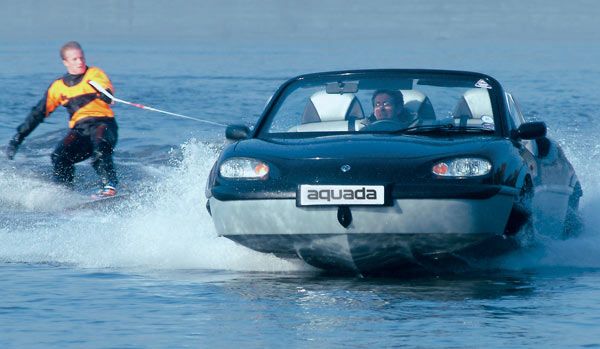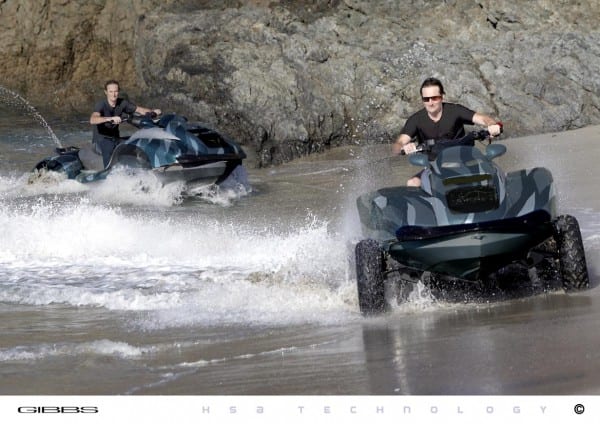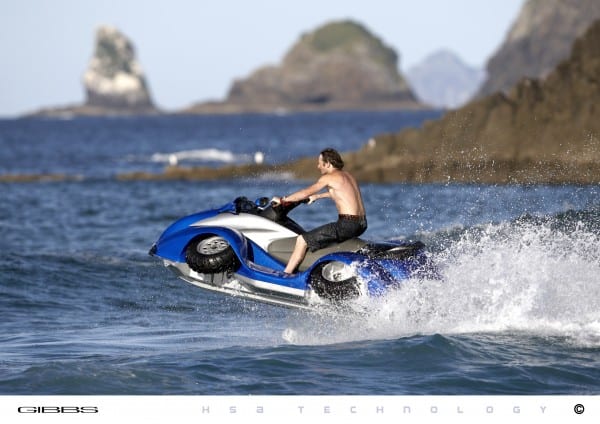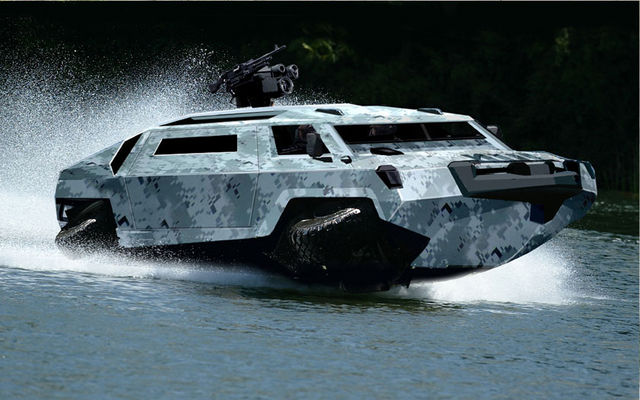
Gibbs Technologies brings you one step closer to living like James Bond. That’s not their tag line–they promote themselves more discreetly than that. But when you tear up the highway in your sports car, drive it into the water, flick a switch, and glide down a river, perhaps stopping to wave at passing gawkers, you know it inside: You are 007.
Gibbs calls it High Speed Amphibian technology (HSA). We call game-changing fun. Gibbs’ HSA vehicles include the Aquada, a sports car that converts into a speedboat; the Quadksi, a quad/jetski combo, and the Humdinga, a Hummer-like 4WD vehicle that cruises on land and water. Their patented technology, which took more than a decade to develop, can also be licensed to turn any car into an amphibian.

New Zealand business tycoon Alan Gibbs first tried the concept in 1995. Several years later, multitalented automotive engineer Neil Jenkins partnered with Gibbs to perfect the vehicles’ engineering. Jenkins assembled a group of engineers who, with Gibbs, mastered the design of what will likely become the world’s first mass-production amphibious vehicles.
Jenkins is now the Chairman of Gibbs Technologies. Business Pundit caught up with him to explore the business behind Gibbs’ groundbreaking inventions. (Read more about the vehicles’ fascinating technology here.)
BP: Why has it taken your products so long to hit the market?
Jenkins: Several reasons. First, until Gibbs Technology came along, an awful lot of people tried to do what we do, and failed completely and utterly.
In fact, the US government gave General Dynamics millions to do what we do, build an expeditionary amphibious vehicle. They have not performed that well, to our knowledge so far, and that’s because it is extremely difficult to do. As an engineering challenge, you are right at the limit of knowledge and of technology, so it’s a very difficult task.
The first 3-4 years were us trying to work out the science behind what we needed to do. Once we had finished all the solutions we needed, we spent a couple of years working on the product design, because there’s no better way to test engineering in action than putting them into reality. That took us a few years.
In 2003 I think it was, we had a press release of the technology and showed the Aquada for the first time. We were looking to put that into low-volume production at the end of 2004.
Unfortunately, our engine supplier at the time, Britain’s Rover, went into bankruptcy, and we lost our engine supplier. We decided that rather than sell any of the 50 vehicles that we made, we would be better served to keep those to ourselves, and search for a new engine, so that we could put a proper product line on the market and not have an interruption in terms of the product’s availability.
Because it takes several years to actually put a new engine in, first find a source of a new engine, then integrate it into the vehicle, and meet the appropriate regulations for emissions and so on, it’s quite a lengthy task.

BP: Who is your civilian target market?
Jenkins: The beauty of our products is that all products we’re working on covers the spectrum of potential consumers. For example, the Quadski, at one end of the scale, is relatively low-cost. It’s for off-road and marine use. That will appeal, I think, to a lot of younger people and sportsmen who want a fun vehicle.
At the other end of the scale, we have first responder vehicles. These are unique vehicles for specific rescue applications, flood rescue, and that sort of thing. They will look expensive to the man in the street, but to the first responder community, they will represent great value for the money.
At the moment, if there is a flood rescue issue, those guys have to mobilize trucks, boats, helicopters, all sorts of things, in order to rescue people. With our technology, they will be able to leave the fire depot or whatever depot they’re coming from, drive to the area where the service is needed, drive into the water–and if necessary back onto land or into water–to get to the point of need.
Currently, they don’t have a vehicle that does that, so it’ll be a real step forward in rescue vehicles. They’ll be performing rescues on real people in reasonable health rather than recovering bodies.
BP: What market do you think the Gibbs vehicles will affect the most?
Jenkins: We’re not looking at encroaching on any existing market or take any existing market share from anyone. We’re not competing with a car that someone wants to go shopping in, or a sports boat that people only want to use on the weekend. I think it’ll be a completely new way of using transport.
We’re in a completely different class of purchase. We’ll be competing for money against other forms of transport, I guess, but we have such a unique differentiator that we probably won’t be classed in the same way as a car.
For example, if someone wants to do what we do, which is build normal road transport and good water transport, they would have to buy a boat, a trailer, and a truck to tow it all. Launching a boat takes time and skill.
We’re a vehicle where they could combine all three of those items. Instead of having to store one for some of the time, they could buy and use our vehicle very simply. They could go straight from land to water.
(With our vehicles), it takes 5 seconds to transition from a land vehicle into a boat. Once it’s transitioned, it takes 5 seconds or less to be heading out onto (the water), doing 30-35 miles per hour, which is a respectable speed for any motor boat.
BP: Is it legal to drive into a river in most countries?
Jenkins: In most countries, there is nothing to stop you launching a boat in any water, as long as you comply with the laws of the land and the water authority, (although) there are areas where there are some speed restrictions, there are areas protected from navigation.
Generally, you can take almost any of the major cities in the world, including New York, London, Sydney, all sorts of places. There’s nothing that stops you driving down an available ramp and into a river, cut some traffic and get into the water and get out somewhere else.
All you need is the infrastructure to get in and out of the water, which many cities have. I’m not sure about Manhattan, whether that has many boat ramps, but for example, London has many boat ramps on the Thames.

BP: The first phase of the concept was designed in Detroit, if I understand correctly from the Gibbs story. Does that mean that Ford, GM, or Chrysler–or some of their technologies, employees, or know-how–were involved?
Jenkins: The initial concept of the Aquada and really the initial concepts of high-speed amphibians were undertaken in Detroit for around 18 months-2 years, in 1997-98 I think it was, or 98-99.
During that time, we liaised with a lot of the major suppliers and spoke to the Big 3 in terms of looking for engines and drive train components, but we’ve never had a formal relationship with any of those people. We certainly keep a good look out in terms of what they’re working on and what they’re doing, just in case there’s any source of course, but we don’t have a formal relationship, no.
BP: What would your biggest hope for the success of the Gibbs vehicles be?
Jenkins: That’s a difficult question. I think over the past several years, in our work with different groups, including the military and so on, there’s no doubt in my mind that the technology is very useful and provides a completely new dimension to transport.
My hope will be that it doesn’t take a long time for people to recognize that and then start using it. I hope that people are excited by the technology and excited by the opportunity that it affords them in terms of opening up their transport boundaries.
It’s the ultimate off-road vehicle in the sense that you no longer need land. But the primarily it’s a boat that can launch itself and can recover itself. My hope is that the technology is understood and appreciated and that the market develops quickly.
Neil Jenkins’ most recent challenge, at time of writing, has to do with the US regulatory environment. Visit Gibbs Technologies’ website to find out more about their products and upcoming releases.
